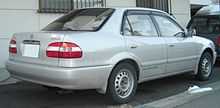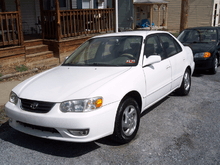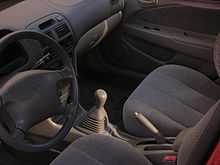Toyota Corolla (E110)
| Eighth generation | |
|---|---|
 | |
| Overview | |
| Manufacturer | Toyota Motor Corporation |
| Also called |
Toyota Carib Toyota Sprinter Chevrolet Prizm |
| Production | May 1995–March 2002 |
| Assembly |
Cambridge, Ontario, Canada (TMMC) Adapazari, Turkey Fremont, California (NUMMI) Toyota City, Japan Durban, South Africa Indaiatuba, Brazil Santa Rosa, Laguna, Philippines Cikarang, Indonesia Chachoengsao, Thailand Thames, New Zealand (CKD) |
| Body and chassis | |
| Class | Compact car |
| Body style |
4-door sedan 2-door coupé (JDM) 3-door hatchback 5-door liftback 5-door station wagon[1][nb 1] |
| Layout | FF layout |
| Platform | Toyota Corolla |
| Powertrain | |
| Engine |
Petrol (EFi):[1] |
| Transmission |
5-speed manual 6-speed manual (JDM)[1] 3/4-speed automatic |
| Dimensions | |
| Wheelbase | 2,465 mm (97.0 in)[2] |
| Length |
Hatchback: 4,120 mm (162 in) Liftback: 4,270 mm (168 in) Saloon: 4,315 mm (169.9 in) Station wagon: 4,340 mm (171 in)[2] |
| Width | 1,690 mm (67 in)[2] |
| Height |
Hatchback, Liftback, Saloon: 1,380 mm (54 in) Station wagon: 1,445 mm (56.9 in) |
| Kerb weight | 1,095 kg (2,414 lb)[2] |
| Chronology | |
| Predecessor | Corolla E100 |
| Successor | Corolla E120 |
The Corolla E110 was the eighth generation of cars sold by Toyota under the Corolla nameplate.
Introduced in May 1995, the eighth generation shared its platform (and doors, on some models) with its predecessor. Due to a recession, Toyota ordered Corolla development chief Takayasu Honda to cut costs, hence the carry-over engineering.
For the general market, the Corolla was offered in Base, XLi, GLi, and SE-G trim levels.
Japan
_BZ-R_coupe_01.jpg)

This was the last Corolla generation to have an equivalent Sprinter model, and the Levin sports package upgrade. The Sprinter Carib wagon was identical to the European Corolla wagon. The Sprinter, exclusive to Toyota Vista Store Japanese dealerships was renamed the Toyota Allex and was modified from a sedan to four-door hatchback.
Japanese models received minor changes in April 1997 with new nose, tail, and interior. The rear panel is totally different, therefore the trunk and tail lights are not interchangeable between the old and facelift models. The new Japanese rear panel is the same as the European model.
Japanese market engines:
- 4A-GE — 1.6 L (1587 cc) I4, 20-valve DOHC, FI, 165 ps (121 kW)
- 4A-FE — 1.6 L (1587 cc) I4, 16-valve DOHC, FI, 115 ps (84 kW)
- 5A-FE — 1.5 L (1498 cc) I4, 16-valve DOHC, FI, 100 ps (73 kW)
- 4E-FE — 1.3 L (1331 cc) I4, 16-valve DOHC, FI, 88 ps (64 kW)
- 3C-E — 2.2 L (2184 cc) I4, diesel, EFi, 79 ps (58 kW)
- 2C-III — 2.0 L (1974 cc) I4, diesel, FI, 73 ps (53 kW)
Japanese market chassis:
- E111 — Sedan, coupe, wagon SE-G, S-Cruise, GT, Spacio, Sprinter Carib (FWD), Levin
- E110 — Sedan LX, XE, SE Limited, Levin
- E114 — 4WD sedan
- E115 — 4WD Wagon Sprinter Carib
North America


Introduced in 1997 (1998 model year), all Corollas for the North American market were now built in Fremont, California (by NUMMI) or Cambridge, Ontario (by TMMC). Unlike the Japanese counterparts, the North American Corolla at this time was only offered as a four-door compact sedan. A new all-aluminum 1ZZ-FE engine powered all Corollas, making this generation lighter than its predecessor. This new engine uses a timing chain instead of a timing belt. It also incorporated laser etched valve guides directly in the block, rather than the old shrink to fit valve guides in the predecessor Corolla motor (4A-FE & 7A-FE). This prevents oil burning and valve guide failure in the future.
In North America, only sedans were offered, and all came with daylight driving lights. This Corolla has a maximum legal carrying capacity of 1,500 lb (680 kg). Grades were VE, CE, and LE. The VE model was the base model available in a 3 speed automatic or the 5 speed manual transmission with 175/65x14 tires. The CE and LE models offered the 4 speed automatic with overdrive or the 5 speed manual transmission with 185/65x14 tires. An optional powered sunroof was offered on the CE and LE models. An optional Touring Package with color matched side skirts, color matched rear mudflaps, a white faced instrument cluster with tachometer and outside temperature gauge, and aluminum wheels was reserved for the VE, CE, and LE models. Side airbags and ABS were optional for the CE and LE models, but very few of them actually had them. The first batch of 1998 Corolla VE's did not have a front sway bar but by June 1998 it was included on all models. VVT-i variable valve timing was added to the engine in model year 2000 with a small increase in power from 120 hp (89 kW) to 125 hp (93 kW) along with child seat anchors added on the rear deck. The introduced VVT-i optimizes cam and valve timing to reduce emissions.
For the 2001 US model year (2000 calendar year), the VE was eliminated and the S model was introduced. The CE became the new base model offered in 5 speed manual or 4 speed automatic transmission and the sporty S replaced the Touring Package. The 2001 model year also got a slight refresh with the new front headlights, redesigned front bumper, auxiliary DC power port with a higher armrest (LE 4 speed automatic models), inside trunk release for accidental lockouts in the trunk, new controls for the air conditioner that had the rear glass defrost button relocated with a button for the recirculation of air, and round reverse lights. The 'sportiness' of the S model built upon the CE models with a gage cluster with tachometer in a red/black theme with an outside temperature gage, a charcoal gray and black interior, standard front fog lamps, color matched side skirts, color matched rear mudflaps, a color matched front grill, a trunk release lever next to the gasoline cap door lever (but not on the remote fob), power mirrors, a trunk light, 14" 'S' model wheel covers, and lighted map lights on the rear view mirror. The S model lacked the 60/40 folding rear seat, or tilt steering of the LE model. The 'S' model had no performance advantage over the other models: it was purely an appearance package.
Toyota official accessories available through dealerships for all trim of the 8th generation Corolla included a color-coded rear spoiler with LED brake light, front bumper bra, 6 disc CD changer, sunroof sunshade, trunk cargo net, keyless entry car alarm, cruise control, gold emblem kit, wood trim dash kit, and black rubber mudflaps.
North American market engines:
- 1998–1999 — 1ZZ-FE, 1.8 L (1794 cc) I4, 16-valve DOHC, FI, 120 hp (89 kW) @ 5600 rpm, 165 nm (122 ft•lbf.) @ 4400 rpm
- 2000–2002 — 1ZZ-FE, 1.8 L (1794 cc) I4, 16-valve DOHC, FI, VVT-i, 125 hp (93 kW) @ 5800 rpm, 169.5 nm (125 ft•lbf.) @ 4000 rpm
Europe and Oceania

This range had different front and rear ends to the Japanese models, though the sides and interior remained mostly the same. It can be distinguished by the round headlights and mesh grille. As a result, a sporting model with a six-speed gearbox was offered. The European three door hatchback is the base for the Corolla World Rally Car (WRC).
In Australia the Corolla liftback is called Seca. Grades for sedan and Seca are Ascent, Conquest, and Ultima. New Zealand market E110s had the 1.3 L (1,331 cc) 4E, the 1.5 L (1,498 cc) 5A-FE, 1.6 L (1,587 cc) 4A-FE or 1.8 L (1,762 cc) 7A-FE petrol engines or the 2.2 L (2,148 cc) SOHC diesel engine as at 2000,[3] whereas Australia only offered the 7A-FE, with a unique turbocharged Sportivo model offered in 2001. In 1997, the Corolla Spacio, with its body panels stamped at long-time Toyota supplier Kanto Autoworks, was introduced as a two-box minivan version and sold as the Corolla Verso, which was technically similar to the Avensis in Europe and the Spacio in New Zealand. The E110 was the last generation of Corolla to have an upmarket Sprinter Carib off-shoot; for Oceania this was based on the five-door station wagon.
In New Zealand, until late 1998, CKD kits were brought in from Japan and assembled in plants located in Thames and Christchurch. Locally produced components were also used, and included items such as tyres, seats, trims, and glass.
In Britain, the models were 1.3 and 1.6 GS, 1.6 GLS, 1.6 CD and 2.0D GS.
This generation received a facelift in 1999, featuring a different nose (the previous round headlights proved unpopular, so it was replaced with twin smaller headlights under a single cover on either side ), and the new ZZ series engines with VVT-i replacing the old A series engines, except in Australia. The same vehicle was used as a taxicab in Singapore, although the North American version was offered in the private car market.
The new "facelift" E11 came with its own new set of optional extras( these however came standard on the SR models ) The Optional Extras included: Front Foglights, Front 'Sports Grill', Plastic Front Lip, Red&Black Interior(Same seat shape as other models), Honeycomb & Silver Dash Dials, OEM 15" Alloy Wheels(Choice of Style), Sunroof, Aluminium Pedals, 6 CD Changer and Sat-Nav built -in headunit.
Asia
Philippines
In the Philippines, the Corolla had 3 grades — the base 1.3 XL, the 1.3 XE and the 1.6 GLi, all launched around December 1997. The XE and GLI variants were given a facelift in 2000, and the name Corolla Altis (the name the Corolla in the Philippines bears now) was introduced for the new 1.8 top-of-the-line model. All were sold until mid-2001, except the XL. The XL came with a 2-spoke urethane steering wheel, wind-up windows, a 5-speed manual transmission, 13" steel wheels, no tachometer and no digital clock. It was sold together with the next generation Corolla Altis until 2005, when from then on it was only sold to Rent-a-car companies and Taxi operators until it was replaced by the Vios J. The 1.3 XE was the same as the XL grade with a dual SRS airbag(unusual for a 1.3 liter car that it doesn't offer it even as option on other competitors) & 14" alloy wheels. The 1.6 GLi was for the top-of-the-line market segment, offering power windows and locks, a spoiler(optional), a digital clock, and a choice of a 5-speed manual or a 4-speed automatic transmission.
Indonesia
_SEG_1.6i_sedan_01.jpg)
This generation of Corolla was launched in early 1996. Initially it was offered in XLi, SE-G, and S-Cruise trim levels, all were powered by the 1.6 liter 4A-FE engine. The All-New Corolla SE-G and S-Cruise came with standard SRS Airbag, which made them the first cars to offer this safety equipment in the compact car segment at that time.
The facelift model Corolla 1.8 XLi and 1.8 SE-G came in late 1998. In addition to the bigger 1.8 liter 7A-FE engine, the Corolla received new front and rear body panels, upgraded interior, and ABS was also standard on the SE-G.
- Batam
In the island of Batam, where used imports from Singapore are popular, the Corolla GLi E110 is one of most common models, in the private car[4] and taxi[5] segment. Together with the local XLi and SE-G, the Singaporean GLi are common sights in this island. Majority of the E110s are the facelifted North American/Japan/Asian models, although there are a few pre-facelift 1995 models.
Singapore
The E110 was one of the best-selling cars during its time in Singapore. Many of these cars were exported to Batam for use as taxis in the 2000s. The pre-facelift E110 is still in use as a police car as of June 2011.
Corolla WRC
The Toyota Corolla WRC (World Rally Car) is special purpose rally car based on the European Corolla 3 door Hatchback, and powered by a modified 3S-GTE engine and 4WD system from the Toyota Celica GT-Four ST205.[6]
It was launched in July 1997, and made its debut in the 1997 Rally of Finland with 1994 World Rally Champion, Didier Auriol, and Marcus Grönholm behind the wheel.
For 1998 WRC season, double World Rally Champions Carlos Sainz joined the Toyota Team Europe, and won the 1998 Monte Carlo Rally. It was the first victory for the Corolla WRC. Didier Auriol won the 1999 China Rally, and Toyota won the 1999 manufacturer's title while the company stopped participating in rallying, in order to prepare for a switch to Formula One in 2002.
WRC Victories
No. Event Season Driver Co-driver 1  66ème Rallye Automobile de Monte-Carlo
66ème Rallye Automobile de Monte-Carlo1998  Carlos Sainz
Carlos Sainz Luis Moya
Luis Moya2  34º Rallye Catalunya-Costa Brava
34º Rallye Catalunya-Costa Brava1998  Didier Auriol
Didier Auriol Denis Giraudet
Denis Giraudet3  28th Rally New Zealand
28th Rally New Zealand1998  Carlos Sainz
Carlos Sainz Luis Moya
Luis Moya4  3rd China Rally
3rd China Rally1999  Didier Auriol
Didier Auriol Denis Giraudet
Denis Giraudet
TRD Motorsports
TRD USA offered a body enhancement package made by Molly Designs for this car, although the kits offered were rare and expensive. The pieces in these kits included front and rear valences, contoured side skirts, optional trunk lip spoiler, and 3 TRD badges. The 98-00 body kit had a different front valance design than the 01-02's due to the 01-02's refreshed front bumper cover. TRD also offered a 1.3 bar radiator cap, quick shifter, freer flowing 95 db legal performance muffler, free flow washable air filter, front strut bar, 16" 5 spoke TRD wheels mounted on 205/45/16 Nitto tires, and performance lowering spring/struts for this car. The rare forged aluminum TRD wheels offered had a +47 offset and weighed 19 lbs.
Gallery
|
Footnotes
- ↑ All measurements, weights and engine and bodystyle data refer mainly to Japanese, European and Oceania specification vehicles
References
- Bibliography
- Matthew-Wilson, Clive (ed). The Dog and Lemon Guide: 2010 Edition. Auckland, New Zealand: Publications (2008) Ltd., 2010.
- Randall, Martynn. Toyota Corolla Owners Workshop Manual: 1998–2000; Saloon, Hatchback, Liftback & Estate, including special/limited editions, 1.3 litre (1332cc), 1.4 litre (1398cc) & 1.6 litre (1587cc & 1598cc) petrol. Sparkford, Yeovil, Somerset, UK: Haynes Publishing, 2006. ISBN 1-84425-286-8
External links
| Wikimedia Commons has media related to Toyota Corolla. |
| « previous — Toyota road car timeline, North American market, 1980s–present (model years) | |||||||||||||||||||||||||||||||||||||
|---|---|---|---|---|---|---|---|---|---|---|---|---|---|---|---|---|---|---|---|---|---|---|---|---|---|---|---|---|---|---|---|---|---|---|---|---|---|
| Type | 1980s | 1990s | 2000s | 2010s | |||||||||||||||||||||||||||||||||
| Model year | 0 | 1 | 2 | 3 | 4 | 5 | 6 | 7 | 8 | 9 | 0 | 1 | 2 | 3 | 4 | 5 | 6 | 7 | 8 | 9 | 0 | 1 | 2 | 3 | 4 | 5 | 6 | 7 | 8 | 9 | 0 | 1 | 2 | 3 | 4 | 5 | |
| Subcompact | Tercel | Tercel | Tercel | Tercel | Tercel | Echo | Yaris | Yaris | |||||||||||||||||||||||||||||
| Starlet | Corolla FX | Prius c | |||||||||||||||||||||||||||||||||||
| Corolla | Corolla | ||||||||||||||||||||||||||||||||||||
| Compact | Corolla | Corolla | Corolla | Corolla | Corolla | Corolla | |||||||||||||||||||||||||||||||
| Matrix | Matrix | ||||||||||||||||||||||||||||||||||||
| Corona | Camry | Camry | Prius | ||||||||||||||||||||||||||||||||||
| Mid-size | Prius | Prius | |||||||||||||||||||||||||||||||||||
| Cressida | Cressida | Cressida | Cressida | Camry Solara | Camry Solara | Prius v | |||||||||||||||||||||||||||||||
| Camry | Camry | Camry | Camry | Camry | |||||||||||||||||||||||||||||||||
| Full-size | Avalon | Avalon | Avalon | Avalon | |||||||||||||||||||||||||||||||||
| Sport compact | Corolla GT-S/SR5 | ||||||||||||||||||||||||||||||||||||
| Celica | Celica | Celica | Celica | Celica | Celica | ||||||||||||||||||||||||||||||||
| Paseo | Paseo | ||||||||||||||||||||||||||||||||||||
| Sports car | Celica Supra | Celica Supra | Supra | Supra | |||||||||||||||||||||||||||||||||
| MR2 | MR2 | MR2 Spyder | |||||||||||||||||||||||||||||||||||


_CSX_liftback_01.jpg)
_Ascent_sedan_(2011-11-17)_01.jpg)
_Ascent_sedan_(2011-11-17)_02.jpg)
_Ascent_Seca_liftback_06.jpg)

.jpg)